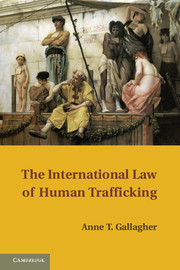Book contents
- Frontmatter
- Contents
- Preface
- Table of Cases
- Table of Treaties and Other International Instruments
- Table of Common Abbreviations
- THE INTERNATIONAL LAW OF HUMAN TRAFFICKING
- Introduction
- 1 The International Legal Definition
- 2 The International Legal Framework
- 3 Specific Legal Issues
- 4 State Responsibility for Trafficking
- 5 Obligations of Protection and Support
- 6 Obligations Related to Repatriation and Remedies
- 7 Obligations of an Effective Criminal Justice Response
- 8 Obligations to Prevent Trafficking and Respond Lawfully
- 9 Issues of Compliance, Implementation, and Effectiveness
- Epilogue
- Select Bibliography
- Index
- Frontmatter
- Contents
- Preface
- Table of Cases
- Table of Treaties and Other International Instruments
- Table of Common Abbreviations
- THE INTERNATIONAL LAW OF HUMAN TRAFFICKING
- Introduction
- 1 The International Legal Definition
- 2 The International Legal Framework
- 3 Specific Legal Issues
- 4 State Responsibility for Trafficking
- 5 Obligations of Protection and Support
- 6 Obligations Related to Repatriation and Remedies
- 7 Obligations of an Effective Criminal Justice Response
- 8 Obligations to Prevent Trafficking and Respond Lawfully
- 9 Issues of Compliance, Implementation, and Effectiveness
- Epilogue
- Select Bibliography
- Index
Summary
This book is not a specialist treatise in the usual sense. More accurately, it represents an attempt to apply the science and tools of international law to a specific, contemporary issue. From this perspective, it is as much about sources of international legal obligation, the formation of international law, the doctrines of responsibility, and theories of compliance as it is about trafficking. The book's focus is essentially a problem-solving one: The international community has identified trafficking as a problem and decided that law will be used to structure and enable at least part of the solution to that problem. By providing a clear and organized explanation of the law as it is, the capacity of those who are in a position to use international law to hold States and others to account is hopefully strengthened.
The book has evolved out of more than a decade of writing and practice. It reflects experiences and insights from my working life as a UN official, as a teacher and scholar of international law, and as a practitioner in the field. From that perspective, more persons than can reasonably be named have contributed, in one way or another, to the final product. I acknowledge in particular Mary Robinson. It was under her leadership as UN High Commissioner for Human Rights that I first began working on trafficking and it was from my time with her that I learned valuable lessons about the politics of international lawmaking.
- Type
- Chapter
- Information
- The International Law of Human Trafficking , pp. xiii - xivPublisher: Cambridge University PressPrint publication year: 2010

